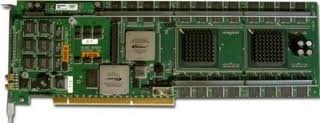|
Accelerator Board
What IS a PLC?
The letters PLC, in electronic control and automation realms, are an abbreviation and stand for Programmable Logic Controller. Texas Memory Systems delivers high-performance DSP hardware and high-performance DSP software. In classical computer marketing all computer manufacturer’s touted the speed of their hardware. Now as hardware gets incredibly fast the marketing emphasis is put on achieving this speed in real world applications. This usable performance is directly related to the hardware-software interface efficiency.The TMS DSP software suite has been designed to operate as a stand-alone application development environment, or to integrate into the XMIDAS application environment (via VPX). The stand-alone environment offers features that are unsupported by XMIDAS. One such feature is dynamic configurability, allowing application changes without requiring a full restart. This stand-alone environment has been optimized for latency and throughput, allowing the final operator to scrutinize signals-of-interest or run full speed analysis of vast amounts of data. Pronounced as separate letters it is the abbreviation for central processing unit. The CPU is the brains of the computer. Sometimes referred to simply as the central processor, but more commonly called processor, the CPU is where most calculations take place. In terms of computing power, the CPU is the most important element of a computer system. On large machines, CPUs require one or more printed circuit boards. On personal computers and small workstations, the CPU is housed in a single chip called a microprocessor. Since the 1970's the microprocessor class of CPUs has almost completely overtaken all other CPU implementations. The CPU itself is an internal component of the computer. Modern CPUs are small and square and contain multiple metallic connectors or pins on the underside. The CPU is inserted directly into a CPU socket, pin side down, on the motherboard. Each motherboard will support only a specific type or range of CPU so you must check the motherboard manufacturer's specifications before attempting to replace or upgrade a CPU. Modern CPUs also have an attached heat sink and small fan that go directly on top of the CPU to help dissipate heat. Two typical components of a CPU are the following: The arithmetic logic unit (ALU), which performs arithmetic and logical operations. The control unit (CU), which extracts instructions from memory and decodes and executes them, calling on the ALU when necessary. Short for floating-point unit, a specially designed chip that performs floating-point calculations. Computers equipped with an FPU perform certain types of applications much faster than computers that lack one. In particular, graphics applications are faster with an FPU. Some microprocessors, such as the Intel 80486 and Pentium, have a built-in FPU. With other microprocessors, you can usually add an FPU by inserting the FPU chip on the motherboard. Floating-point units are also called numeric coprocessors , math coprocessors , and floating-point processors . |
